Vietnam's somewhat mysterious
Central Highland region is often missed off the usual tourist routes across Vietnam. It is a land full of mountains, primitive forests and small ethnic minority communities clinging to their identity amidst mass colonisation of the region. The rugged wilderness of the Central Highlands is the perfect place for those who want to discover the undisturbed beauty and isolated communities of Vietnam.
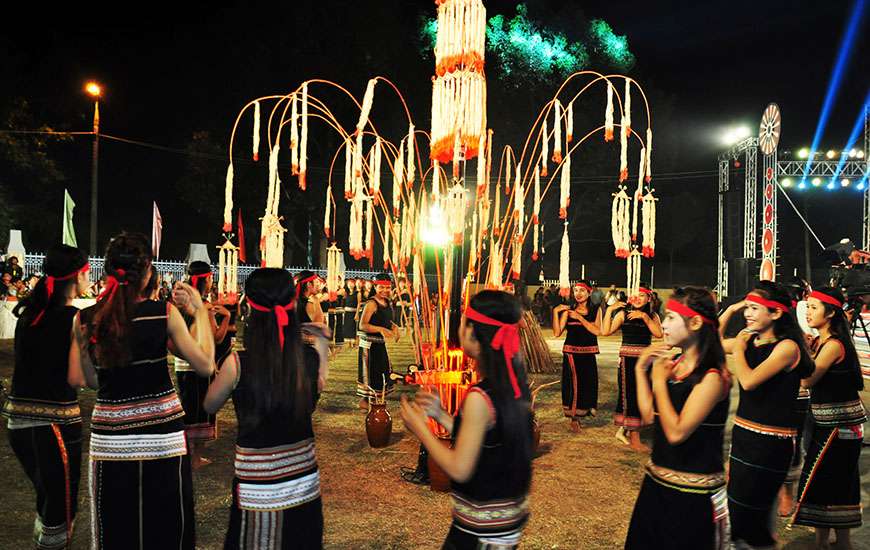
A traditional dance number.
The
Central Highlands incorporates five provinces: Dak Lak, Dak Nong, Gia Lai, Kon Tum, and Lam Dong. The region sits on a series of platueas and neighbours Loas and Cambodia. For a long time, the region was left largely undisturbed, populated mainly by the Degar who were given the name Montagnards by the French. The group is made up of many ethnic minority communities, the largest being the Jarai, the Rade, the Bahnar, the Koho, and the Mnong. For the most part, the highlanders lived undisturbed, and it wasn't until the French illustrated the agricultural value of the land that things began to change. The gradual colonisation of the area by the Vietnamese population led to protests by the native inhabitants.
This along with longstanding tensions between the ethnic minority communities and the government led to a ban on tourist visits to the area in the early 2000s. Although the restrictions have since been lifted, there are some areas that still require police permits, tour guides or hightened sensitivity when travelling.
That being said,
the Central Highlands offer a fantastic chance to experience a piece of Vietnam that is yet to be transformed by tourism. It is not only, the chance to discover the cultures of these highland communities that attracts people to the Central Highlands. The area is also one of outstanding natural beauty with a number of fantastic national parks. It is also home to some amazing species of animals including a small number of elephants and tigers.
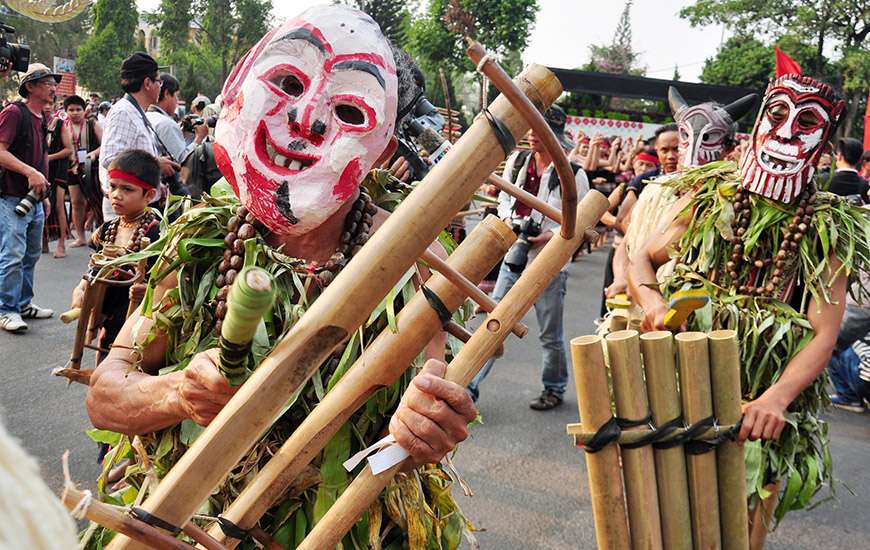
Unique cultural artefacts from the Central Highlands.
The average temperatures in the Central Highlands are cooler than the coastal areas because of the elevated altitude. Temperatures do still reach the 30s from around February to April. The dry seasons runs from November to April and the wet season from May to October. The best time to travel in the central highlands is after the wet season when the land is at its most verdant and the temperatures begin to rise.
Most people choose to travel through the main regions of the Central Highlands either as part of an organised tour or independently by motorbike. Travelling either independently or as a passenger on a motorbike is a fantastic way to take in the incredible scenery on the journey. The larger towns, though mostly unremarkable in themselves provide a good place to rest and a base for further exploration of
Dak Lak Province.
Buon Ma Thuot
The
capital city of Buon Ma Thuot was the location of the fateful battle in 1975 which led to the retreat of the South Vietnamese Army. Since the devastation of the war, it has been rebuilt, modernised and the maintown is similar to many other towns in Vietnam. This is largely due to the high levels of immigration from other areas in Vietnam. That being said, there are still plenty of interesting villages belonging to the ethnic minority communities and beautiful nature spots to explore in the surrounding areas.
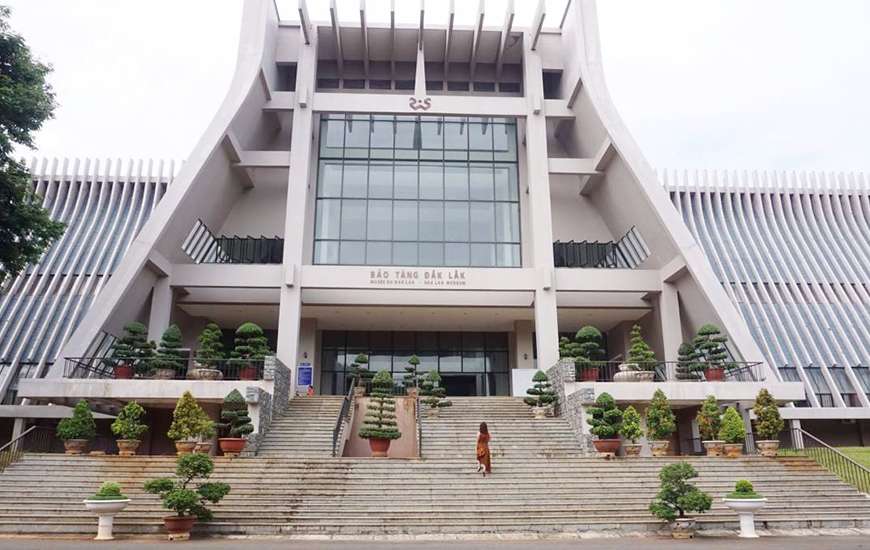
Buon Ma Thuot’s Ethnographic Museum is a great place to learn about Vietnam’s ethnic minorities.
The
Ethnographic Museum in Buon Ma Thuot is a great place to begin the discovery of the many interesting cultures in the Central Highlands of Vietnam. The museum provides great examples and explanations of some of the cultural activities and ceremonies that take place in the ethnic minority villages. The information can be extremely useful as the inherent language barrier often prevents in-depth explanation in the villages themselves. Of particular interest are the different funeral rituals such as the tomb abandonment ceremonies.
Lak Lake is the ideal place to experience the natural, untamed beauty of the countryside and discover the traditional villages that inhabit its shores. The wide expanse of water, the largest in the region, sits amongst the undulating forested mountains. Small wooden boats are available for rides around the lake and most days there are local villagers from the Mnong village fishing either out on the lake or along the shore. There are a number of villages dotted around the perimeter of the lake which are welcoming to foreign visitors. The traditional stilt houses of the Mnong community are humble yet beautifully crafted and are an insight into their culture and way of life. It is also possible in these ares to organise a performance of the gong dance. The gong is a sacred instrument and is believed to be linked to the gods; the older the gong, the stronger its connection. The importance of the gong is a strong belief across the central highland, and the rituals surrounding it have even been recognised by UNESCO as a Masterpiece of Oral or Intangible Heritage of Humanity.
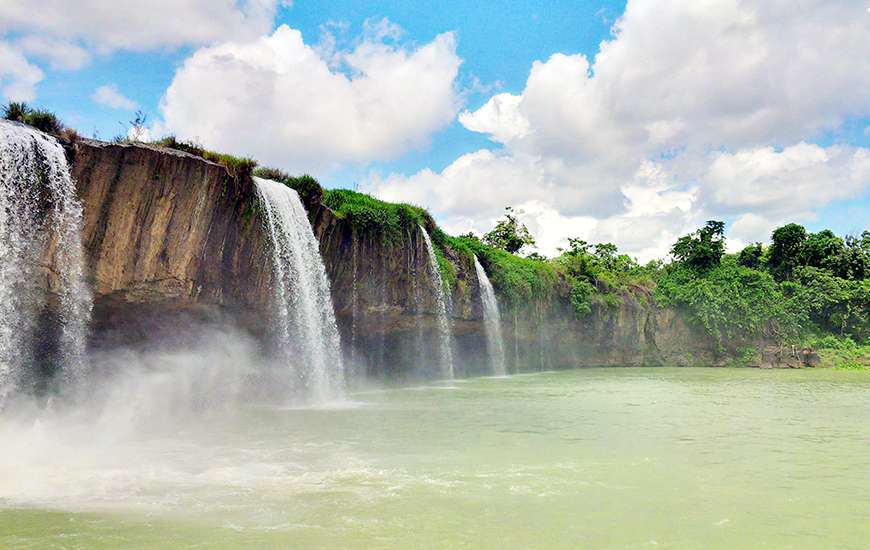
Dray Nur Waterfall depositing huge amounts of water.
Another short journey from Buon Ma Thuot is the ruggedly beautiful
Dray Nur Waterfall. There is a powerful surge of water which cascades over the rock face before crashing into the pool below. The waterfalls are at their most impressive when the flow is at its strongest, and the light of the sun catches on the water. A little further from Dray Nur is another waterfall named Dray Sap. While not as big or impressive as Dray Sap, this picturesque waterfall also makes for a good picnic spot or simply somewhere to bask in nature's charm.
Just a few kilometres outside of Buon Ma Thuot is an Ede Village named
Ako Dhong where visitors can learn more about life in a traditional village. The town is an affluent one owing to its production of coffee, and while there are some modern houses, there are also many beautiful traditional wooden stilt longhouses. The wooden structure of the houses and the gardens that surround them create a harmony with the rich, verdant lands around them. As well as retaining the traditional style of housing, the villagers also strive to keep other traditions such as the production of ruou can wine and the weaving of beautiful brocades.
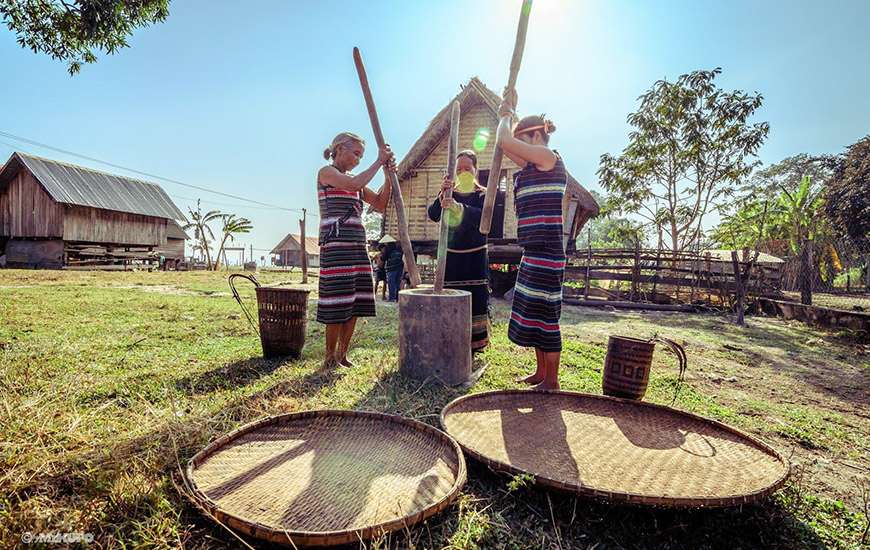
Local women performing their daily tasks.
Yok Don National Park is easily accessed from Buon Ma Thuot. The park encompasses a whopping 115,000 hectares of protected forest which feels wild and enchanting and alive with wildlife. There is a tourist centre at the park where local guides, whose accompaniment is mandatory, wait to accompany visitors around the park. They not only provide safety but can also share expert knowledge and aid in spotting some of the many species of wildlife hiding amongst the trees. The park is home to some rare and endangered species such as tigers, elephants, and leopards but due to overhunting, its is very rare to come into contact with any of these animals. There are, however, plenty of other animals which are more likely to make an appearance such as the wild monkies or the hundreds of colourful bird species. Accommodation is available in the park for those wanting to take their time and explore the wilderness over a few days. The organised tours are of varying length and ability, and some also feature a night safari for a better chance of spotting the wildlife. There are also four ethnic minority villages within the park, three of which can be visited with one of the guides. Other activities within the park include taking a boat ride, trekking to the Buddha Cascade or simply relaxing in a hammock and taking in the sights and sounds of nature.
Cat Tien National Park
The wild and sublime
Cat Tien Natural Park is a 260-kilometre drive south-west from Buon Ma Thuot. Amongst the tropical jungles and bamboo forests are glassy streams and swamplands some of which swell and flood during the wet season. This large and sprawling national park is perfect for hiking or cycling and can be enjoyed either as a day trip or spread over a few days.
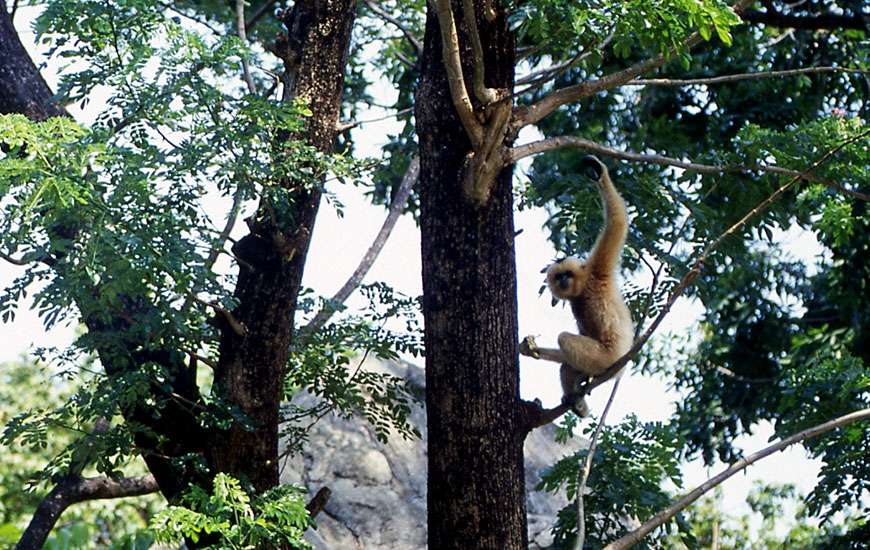
Lucky visitors might spot an endangered langur while in Cat Tien.
The area is listed by UNESCO as a biosphere reserve zone, one of 6 throughout Vietnam which serves to protect the magnificent fauna and flora species within the park. Over 100 types of mammal can be seen within the park with the help of the expert guides. More easily spotted are some of the 350 different species of bird or the 400 different species of butterfly. As well as the many fascinating species roaming wild amongst the forest, there are also a number of different animals that can be seen up close in the park's two sanctuaries. The first is the Endangered Primate Species Centre which homes gibbons and langurs amongst others with the intention of release back into the wild, and the second is the Cat Tien Bear Rescue Shelter. The park has many different trekking routes, most of which should be done with the accompaniment of a guide. Popular options include trekking to Crocodile Lake or an early morning trek to spot families of Gibbons perched amongst the trees.
Kon Tum
Similar to Buon Ma Thuot, Kon Tum saw mass devastation at during the America-Veitnam War. Now, however, the ambience is peaceful and inviting, and the town is a good base for exploring the many ethnic minority villages which surround it. The town itself has some interesting aspects such as the ion of Christain buildings. The architecture of the
Montagnard Church is particularly interesting as it combines aspects of French colonial design crafted all in wood.
Outside of the sleepy town, there are a number of different ethnic minorities living in traditional villages, most of which are welcoming to visitors although it is still recommended to travel with a guide. There are eight different minority groups in the area each with their own unique culture. There are however some similarities between the villages. Whilst travelling through the villages, the importance of the communal houses known as
rong becomes apparent. These elevated, wooden structures which feature impressively tall thatched wooden roofs are used for ceremonial and communal purposes.
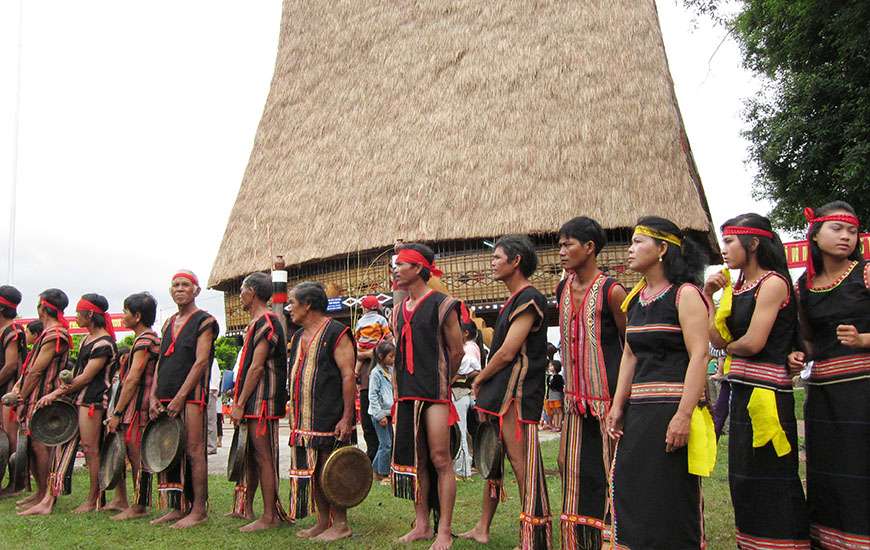
Locals lining up for a performance using their traditional gongs.
Another fascinating aspect of local life, which can be seen in the elaborate graveyards, are the
funeral rituals. Also interestingly, many of the villages have a
Catholic church due to the influence of missionaries who found themselves in exile in the region. Musical instruments also feature heavily in the culture, especially
gongs. Those travelling at the right time will be lucky enough to encounter a sacred performance. When travelling through the villages especially with a local guide, it is not uncommon to be invited into homes or events where the welcoming and friendly nature of the local people shines through. A common form of bonding is drinking ruou can, the potent sticky rice wine, from a communal pot through bamboo straws.
Plei Ku
Much like the other areas in the Central Highlands of Vietnam,
Pleiku took a hard blow at the end of the America - Vietnam War. Its central location was used by the South Vietnamese and American troops as a base but eventually succumbed to the North Vietnam troops in 1975. The defeat left many local, indigenous people in danger with many fatalities. The town itself was completely destroyed and has since been rebuilt in a mostly modern, uninspiring style.
Pleiku also saw more unrest in the early 2000s with the anti-government protests taking place in the city which resulted in restrictions on tourist travel in the area. These restrictions mean that some areas still require a permit or tour guide. Although it can require a bit of preparation a trip through the unspoilt countryside and traditional villages is well worth the effort. Very few places throughout Vietnam remain as pure and wild as the countryside in this region. There is plenty of rural charm and preserved culture just outside of the main town waiting to be discovered. The geological makeup of the area has created some beautiful natural features. The great, mountainous surroundings are a result of the volcanic activity from up to 30 million years ago.
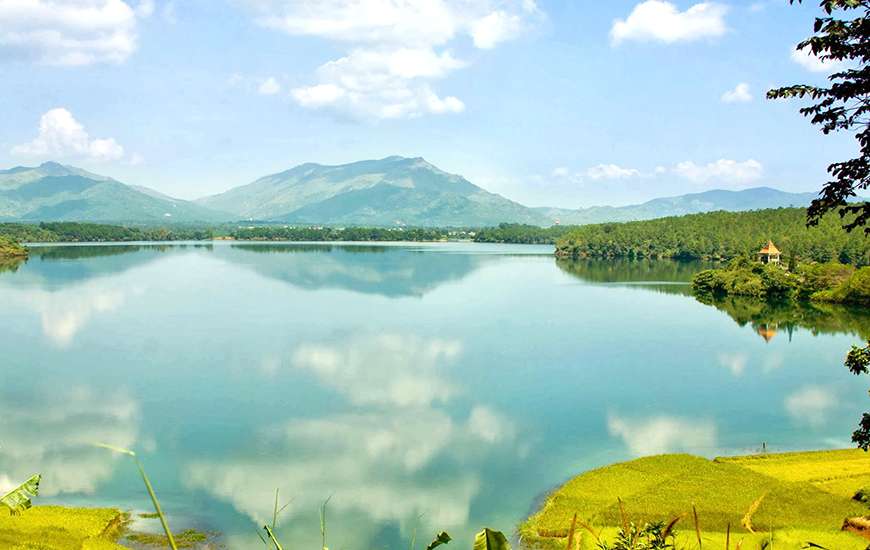
The waters of Bien Ho are incredibly clear.
One example of this is
Bien Ho, a vast lake in a dormant volcanic crater formed millions of years ago. The charm of this pine-encompassed lake is its unadulterated rugged beauty, unspoilt by modern developments. From early in the morning, the lake reveals its beauty underneath the rolling clouds which give way to midday sun and fresh mountain air. The flat, glassy water changes colour throughout the day mirroring the sky from bright blue to golden as the sun the sets. As well as being a fantastic place to relax and bask in nature, the lake also provides sustenance for many of the ethnic minority communities living around its perimeter. Local villagers can often be seen fishing in the lake sometimes with competition from the kingfishers who swoop down hoping for a lucky catch.
Another area which has managed to retain its original beauty is
Phu Cuong Waterfall. This thundering cascade sits in the middle of the countryside surrounded only by thick green vegetation and giant, smooth boulders. It is best visited just after the rainy season when the flow of water is at its strongest but can also be safely accessed. The water that crashes over the rocks and into the pool below, creates a refreshing mist which rises up and fills the air. When the sun is strong in the sky, its light disperses through the fall creating a delicate rainbow which adds magic to the already beautiful scenery.
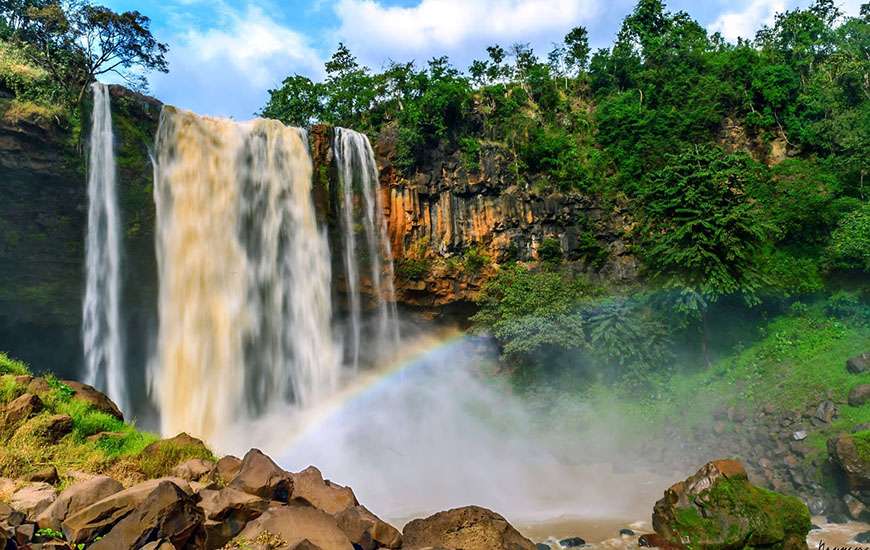
Phu Cuong Waterfall creating a rainbow.
Pleiku also has some interesting architecture in its religious buildings.
Minh Thanh Temple, which sits south of the main city, is a relatively new temple built in the Taiwanese style. The temple itself has a resplendent beauty, the red and gold nine-tiered pagoda shines in the midday sun. The grounds around the temple are equally as captivating, decorated with bonsai, lotus lakes, and religious statues. As well as the tranquil ambience and ornamental grounds, the temple also features some interesting artwork which depicts the grizzly fate of those condemned to hell.
The
Plei Chuet Montagnard Church is another religious building, this time Catholic, with an interesting design. This church is built in the rong house style traditional of the region. Although the church features much of the iconography synonymous with Catholicism, it has been tweaked to be more aligned with the style of the indigenous community.
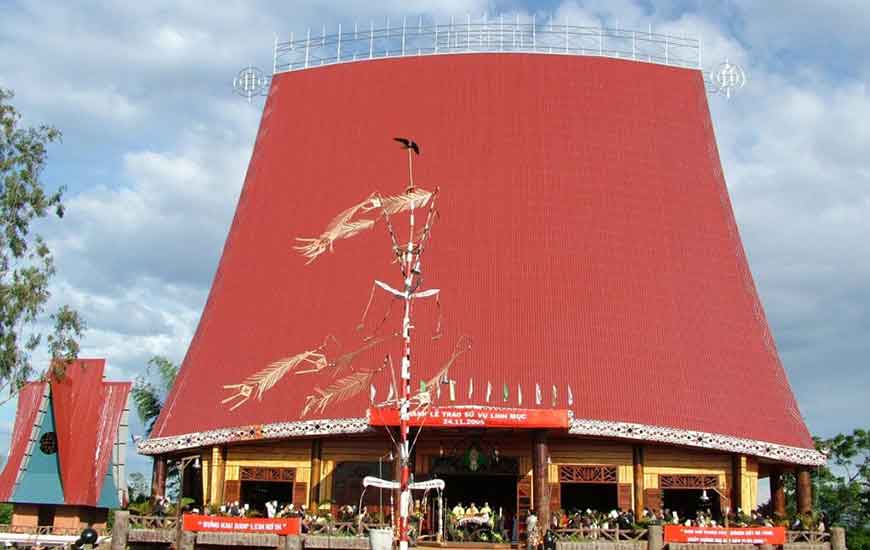
Plei Chuet Montagnard Church, an unusual look for a Catholic Church.
Pleiku also has many ethnic minority communities scattered throughout its countryside. These, however, can be more difficult to access due to the travel restrictions in the area and should be arranged with a guide. Visiting the different villages illustrates how customs and traditions change even within the same area. Of particular interest are the burial rituals of the different cultures which are apparent in the eye-catching graveyards. The graveyard in a
Plei Phun, a Jarai community, features small house like structures by each grave decorated by wooden sculptures of people. It is also a great opportunity to experience the welcoming nature of the local communities and find out more about their way of life.
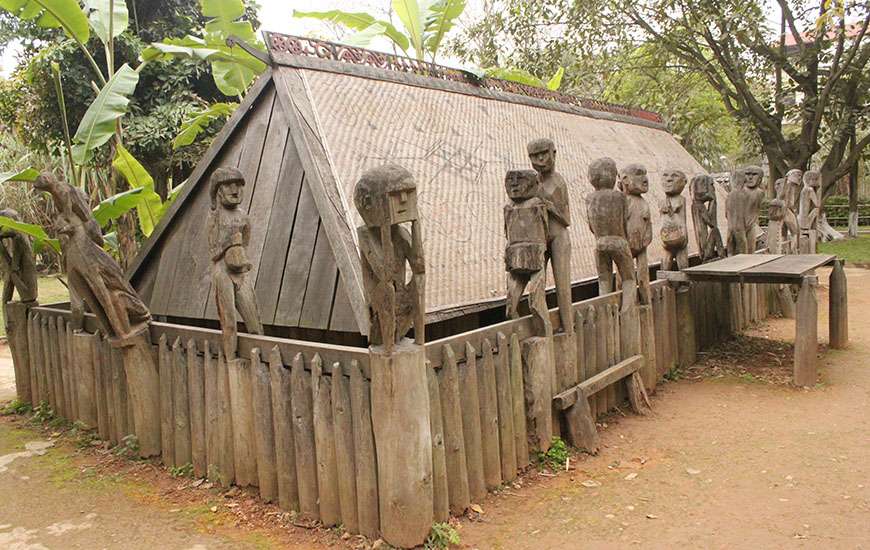
Wooden sculptures in Plei Phun graveyard.
Food and Drink
The Central Highlands of Vietnam also have their own distinctive cuisine owing to its highland geography and traditional cultures.
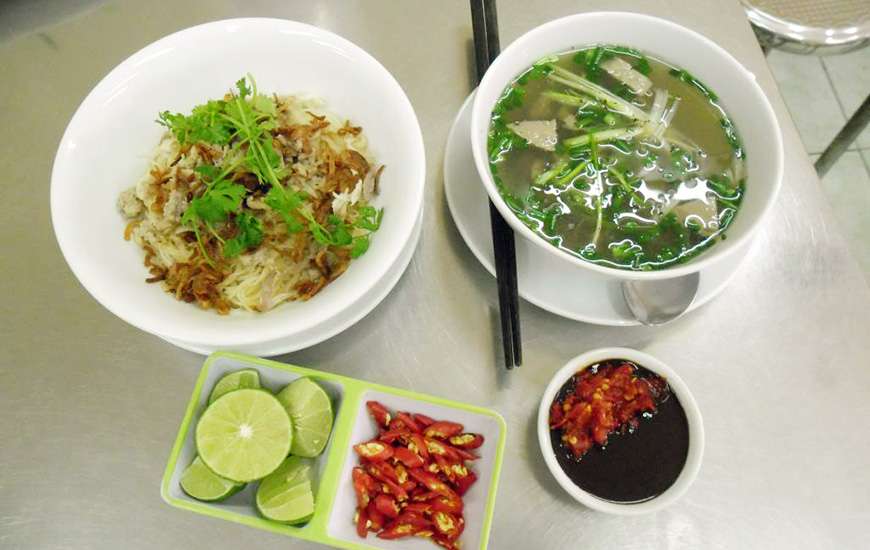
A typical meal in the Central Highlands.
Pleiku has its own unique version of the traditional dish pho.
Pho kho Gai Lai is almost like a deconstructed bowl of pho with the noodles and meat being served separately to the broth. The comforting combination is served with the usual accompaniment of fiery chilli and pungent garlic that warms the body from the inside out.
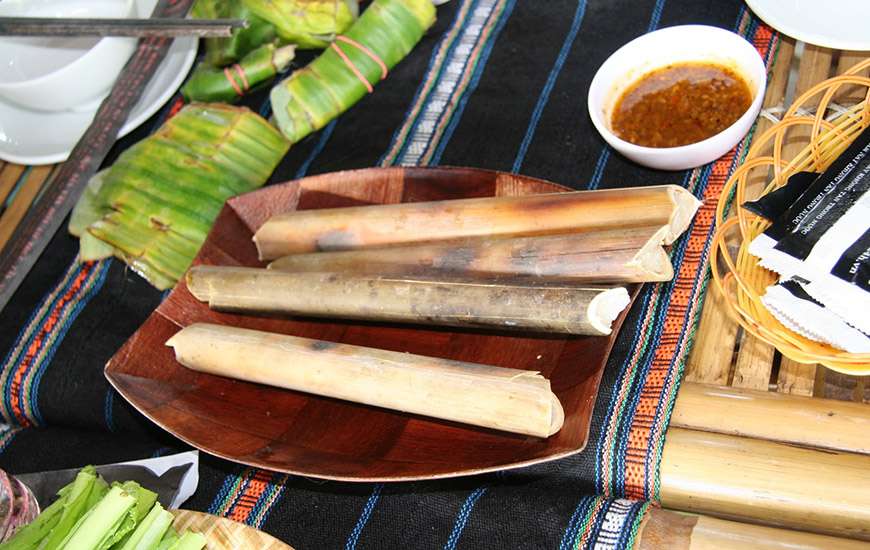
Seasoned rice in a coconut tube, known as Com Lam.
Com lam, or bamboo rice, is another dish traditional of the region. The flavoursome and fragrant rice dish was originally a way of preparing rice which would last on long journies across the mountains but has remained a well-loved dish. The rice is mixed with coconut water and seasonings before being placed inside the bamboo tube and cooked over hot coals.

Ruou Can wine in traditional jugs.
Ruou can is one of the most famous aspects of the Central Highlands cuisine as it is not only a popular drink but also a deeply ingrained part of the culture. Glutinous rice wine is fermented in large earthenware jugs with a combination of herbs dependent on the village. After roughly one month, the concoction is ready to be drunk straight from the jug. Many people will drink from the same jug using long thin straws traditionally made of bamboo. Ruou can is a staple at any big occasion within the community or for welcoming guests, the act of sharing creating a bonding atmosphere.
Festivals and Events
The space of gong culture in the Central Highlands was recorded on the UNESCO list of Intangible Cultural Heritages of Humanity. Throughout the region, gongs play a significant role in connecting the people with their gods. It is widely believed that each gong is connected to a god and each gong has a different value and that as the gong ages, it becomes more powerful. Rather than being a feature of one particular festival, gongs are a significant park across all festivals and traditional events with each area having their own unique style.
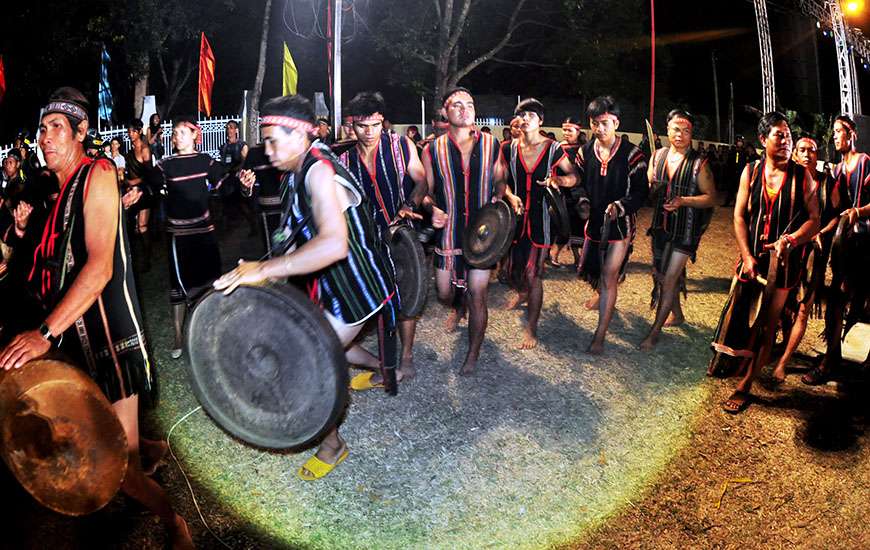
Gong festival underway.
Because of the many different ethnic minority communities in the region, there are hundreds of traditional festivals throughout the year. Many of the communities have an animist belief system in which praying to the gods or spirits for health and prosperity are part of village life.
The
Village Land Praying Festival is a Ba Na celebration which takes place in Gia Lai and Kon Tum in the 2nd and 3rd lunar months. This ceremony takes place to pray for prosperous conditions in the upcoming year.
The Mnong also have a festival to pray for prosperity, the
Com Moi Festival which takes place in the beginning of August. Offerings of food and tools are made to give thanks to the gods and pray for favourable conditions. This is followed by a feast and drinking of ruou can wine.
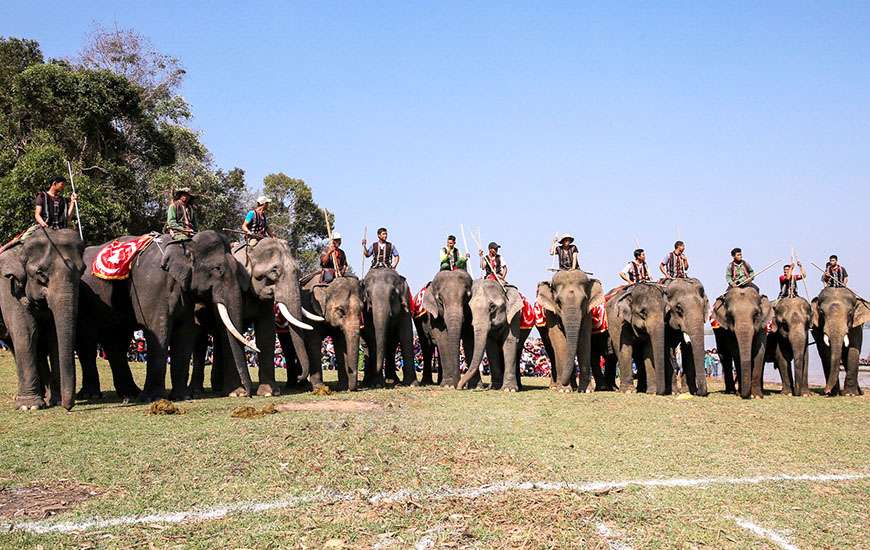
Contestants lining up for the elephant racing festival.
The Elephant Racing Festival is unique to the region and evolved from the local tradition of domesticating wild elephants. It is a Mnong festival which takes part in the third lunar month in Don Village. In preparation for the festival, people feed their strongest and fastest elephants a rich diet to better their chances of winning. The start of the race is signalled by the sounds of the tu va, a traditional horn. People dressed in their finest traditional clothing flock to see the majestic creatures stampede around the track. The winning elephants are rewarded with all sorts of treats and admiration. The jovial nature of the festival continues into the night with feasting, dancing, drinking of ruou can wine, all accompanied by the sound of the sacred gong.